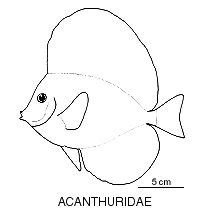- Classification
- ACTINOPTERYGII
- PERCIFORMES
- ACANTHURIDAE
-
Fish Classification
-
Class
ACTINOPTERYGII Ray-finned fishes -
Order
PERCIFORMES Perches and allies -
Family
ACANTHURIDAE Surgeonfishes
Family ACANTHURIDAE
A family of tropical marine fishes that live mostly on coral reefs, named for the sharp spine or spines on the tail base (the caudal peduncle). Members of one group have a single spine that folds into a horizontal groove. Other species have one to six fixed keel-like spines on each side of the caudal peduncle. Surgeonfishes use their sharp spines to defend themselves and can slash other fishes.
Most have deep, compressed bodies, eyes high on the head, a single long-based dorsal fin, tiny scales and a small terminal mouth with a single row of small close-set teeth. Members of the genus Naso, commonly known as unicornfishes, have a horn-like projection in front of the eye. Some species are brightly coloured. Most surgeonfishes graze on benthic algae, although a few feed on zooplankton or detritus.
More Info
|
Family Taxonomy |
Family with 85 species in 6 genera. All genera and 50 species are found in Australian waters. |
|
Family Distribution |
Widely distributed in the tropical and subtropical Atlantic, Pacific and Indian Oceans; absent from the Mediterranean Sea. They live in pairs, in small foraging units, harems, and often in huge spawning or feeding schools along shallow rocky shores and on coral reefs. |
|
Family Description |
Meristic counts: Dorsal fin IV-IX, 19-31; Anal fin II-III, 19-36; Pelvic fin I, 3 or I, 5. Species have a single row of small teeth in the jaws, used mostly for grazing on algae. |
|
Family Size |
Species range in size from 15-100 cm, although most are smaller than 50 cm. |
|
Family Feeding |
Most species are herbivores, grazing on benthic algae on coral reefs. A few feed on zooplankton or detritus. Although some surgeonfishes are solitary, they often graze over the reef in very large schools. This strategy may overwhelm small territorial damselfishes that aggressively guard patches of algae on reefs. |
|
Family Reproduction |
The sexes are separate and fertilization is external. Surgonfishes often aggregate in huge numbers before spawning. Most surgeonfishes spawn in groups although some form spawning pairs or groups of pairs. They are broadcast spawners and have pelagic eggs and larvae. Late stage larvae are circular with transparent bodies except for their silvery abdomens. |
|
Family Commercial |
Some surgeonfishes are important food fish, although cases of ciguatera (fish poisoning) have been reported. Many of the smaller brightly-coloured species are popular aquarium fishes. |
|
Family Remarks |
The dorsal, anal and pelvic fin spines of the Blue Tang, Paracanthurus hepatus, and some species of the genus Naso, are venomous. |
|
Family Biology |
Most acanthurids are herbivores and, along with other fishes, are important members of coral reef communities. They are the lawn mowers on the reef, and prevent thick mats of filamentous and leafy algae from smothering the corals. |
|
Author |
Dianne J. Bray |
References
Allen, G.R., N.J. Cross, C.J. Allen & D.F. Hoese. 2006. Acanthuridae, pp. 1732-1744. In: Beesley, P.L. & A. Wells. Zoological Catalogue of Australia. Volume 35. ABRS & CSIRO Publishing, Part 3. (as Acanthurus nigroris)
Choat, J.H., K.D. Clements & W.D. Robbins. 2002. The trophic status of herbivorous fishes on coral reefs. 1. Dietary analyses. Mar. Biol. 140: 613-623.
Choat, J.H., K.D. Clements & W.D. Robbins. 2002. The trophic status of herbivorous fishes on coral reefs. I. Diet analyses. Mar. Biol. 140: 613-623.
Helfman, G., B. Collete & D. Facey. 1997. The Diversity of Fishes. Malden, MA: Blackwell.
Nelson, J. 2006. Fishes of the World. 4th Ed. John Wiley & Sons, New Jersey.
Randall, J.E. 1956. A revision of the surgeon fish genus Acanthurus. Pacific Science 10: 159–235.
Randall, J.E. 2001. Acanthuridae. Surgeonfishes (tangs, unicornfishes). p. 3653-3683. In: K.E. Carpenter and V. Niem (eds.) FAO species identification guide for fishery purposes. The living marine resources of the Western Central Pacific. Vol. 6. Bony fishes part 4 (Labridae to Latimeriidae), estuarine crocodiles.. FAO, Rome.
Randall, J.E. 2002. Surgeonfishes of the world. Mutual Publishing and Bishop Museum Press, Honolulu.
Randall, J.E., G.R. Allen & R.C. Steene. 1990. Fishes of the Great Barrier Reef and Coral Sea. University of Hawai'i Press, Honolulu.
Robertson, R., N.V.C. Polunin & K. Leighton. 1979. The behavioral ecology of three Indian Ocean surgeonfishes (Acanthurus lineatus, A. leucosternon and Zebrasoma scopas): their feeding strategies, and social and mating systems. Environ. Biol. Fish. 4(2): 125-170.
Sazima, C., A. Grossman, C. Bellini & I. Sazima. 2004. The moving gardens: reef fishes grazing, cleaning, and following green turtles. Cybium 28(1): 47-53.

















































































































































































































































































































































































































